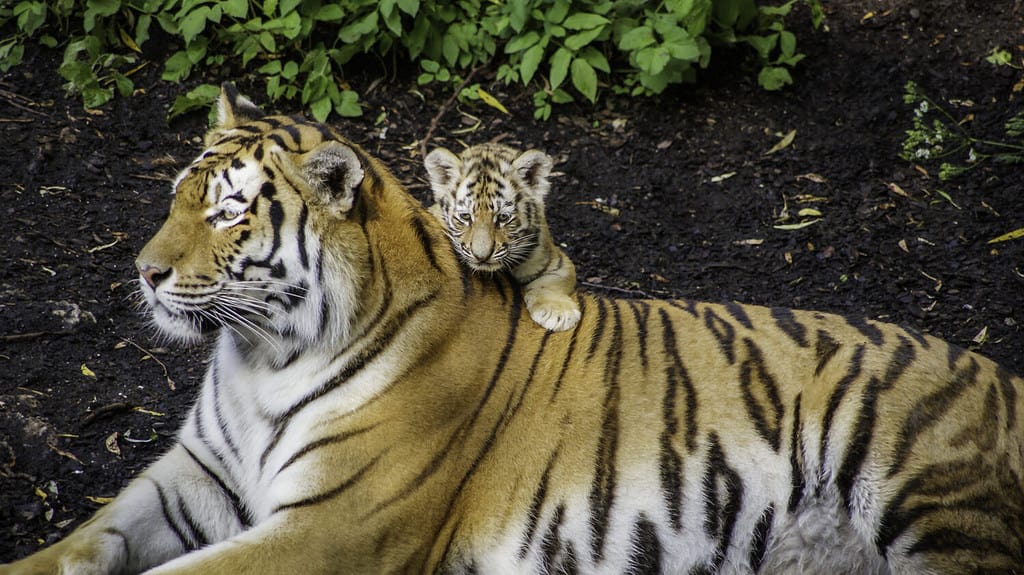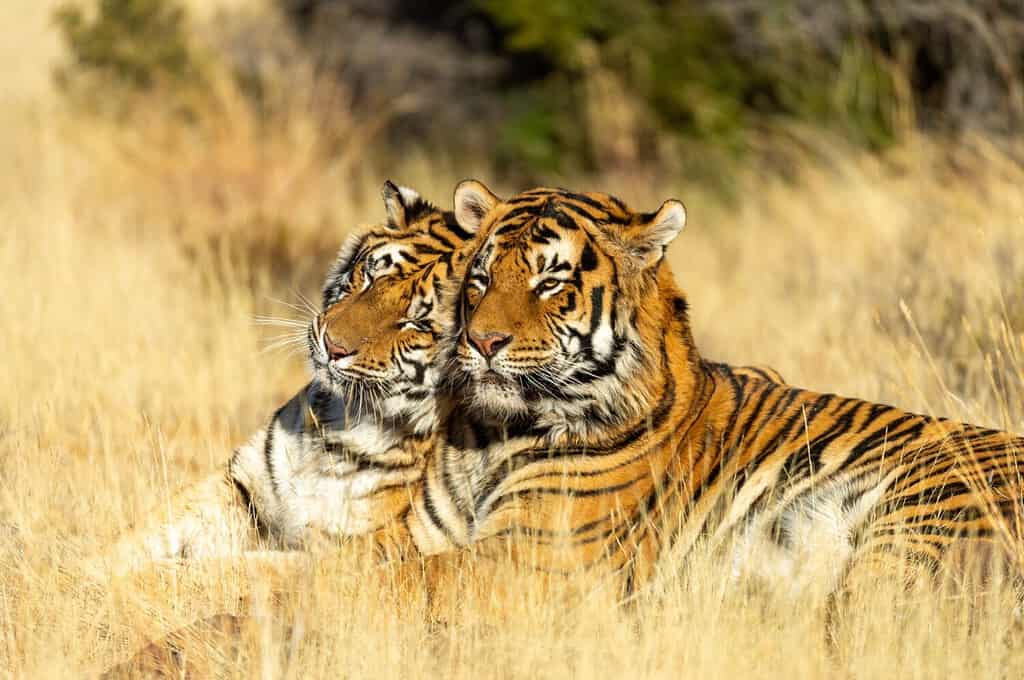The obvious differences between male vs. female tigers are their sex characteristics. In captivity, keepers and researchers can determine a tiger’s gender by looking at their reproductive organs at birth or when the tiger is rescued. But in the wild, it can be difficult, not to mention dangerous, to get that close to a tiger. So scientists studying tigers in their native environment have to rely on other physical differences to determine if a tiger is male or female. Behavior within a group can also provide clues to the tiger’s sex.
Male vs. Female Tigers’ Physical Differences

If you see a tiger in the wild with cubs nearby, there is a very good chance that the tiger is female.
©Thes2680/Shutterstock.com
Male tigers have male reproductive organs, which are visible externally, and female tigers have female reproductive organs. Tigers have fur and don’t often expose their vulnerable undersides so it can be difficult to spot these physical characteristics in the wild.
But in addition to those, the two tigers also have other body differences. Male tigers’ tails tend to be a little bit longer relative to the rest of their body. Looking at tail proportions is a good way to tell the difference between male and female tigers without getting too close. Male tigers also have larger front paws, larger heads proportionally, and are more muscular all around. Females tend to be sleeker.
One of the most easily identified features, even from a distance, is the ruff. Male tigers have a ruff of fur around their necks that often sticks out. While it is not as pronounced as a lion’s mane, the ruff is still a good clue that you’re looking at a male tiger. Of course, juvenile tigers do not have ruffs. Male juveniles may be smaller and look more like females, although they will fill out quickly.
When a female tiger is pregnant, it can be much easier to identify her. Her belly will be larger and she will have more prominent teats in preparation for nursing her cubs after they are born. If a tiger has just given birth and the cubs are nursing, it is a giveaway that she is female.
Tiger Size Differences

Tigers are the largest big cats and the
Siberian
tiger is the biggest of the big cats.
©Jan Stria/Shutterstock.com
Gender and species are two major factors when it comes to a tiger’s weight and size. Male tigers are generally larger than females. Males can weigh up to 600 pounds or more. The Siberian tiger is the largest of the big cats and males are as heavy as 710 pounds. Female tigers, on the other hand, are usually closer to 400 pounds. Some are even smaller. Sumatran tigers are the smallest species. Males, which are larger than females, top out around 400 pounds.
Behavior of Male and Female Tigers

Male and female tigers typically spend time together during the mating season but are solitary at other times.
©manfredstutz/Shutterstock.com
Generally, tigers are solitary compared to many other animals. While this applies to all tigers, it is especially true for male tigers. Cubs stay with their mothers for their first 18 months to 2 years of life as they learn to survive on their own. If you see an adult tiger with cubs nearby, there is a good chance that the tiger is a female.
Male and female tigers will pair up when they mate. If you see two tigers together and one is noticeably larger than the other, you can make a decent prediction on which one is the male and which one is the female. It can be harder to see these differences when the two are not side-by-side.
Male tigers usually wander a bit more than females and stake out a larger territory. This can be hard to see when you just look at a tiger in a video or photo. However, some scientists use technology to map out their movement and territory. Males tend to have larger territories and be more aggressive with other tigers that come into their territory.
What Are Male and Female Tigers Called?

Most tigers are solitary after they leave the care of their mothers.
©Anuradha Marwah/Shutterstock.com
In addition to different physical characteristics and behaviors, male and female tigers have different names. When you are reading about these big cats or looking at research and observations from scientists, you can use the actual vocabulary to know more about the animals being discussed.
Males are called tigers and females are called tigresses. You might also see those of either sex referred to simply as tigers. Baby tigers are called cubs. A group of tigers is called an “ambush.” Because they tend to stay on their own, however, you likely won’t see an ambush of tigers often. Instead, you may see a “streak,” which refers to a mother tiger and her cubs.
The photo featured at the top of this post is © slowmotiongli/iStock via Getty Images
Thank you for reading! Have some feedback for us? Contact the AZ Animals editorial team.






